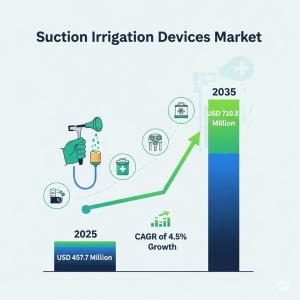Suction Irrigation Devices Set for 1.55X Market Growth by 2035 as Manufacturers Seize MIS Momentum
Advancements in precision fluid management and infection control compliance fuel a 4.5% CAGR in surgical device adoption.
NEW YORK, DE, UNITED STATES, August 13, 2025 /EINPresswire.com/ -- The suction irrigation devices market is poised to grow from USD 457.7 million in 2025 to USD 710.8 million by 2035—an impressive USD 253.1 million expansion, representing a 1.55X increase in market value. This decade-long rise, at a steady 4.5% CAGR, reflects the sector’s central role in enabling safe, efficient minimally invasive surgeries (MIS) worldwide.
For manufacturers, the opportunity is not just in producing more devices, but in delivering solutions that directly address the pain points of surgeons, hospitals, and outpatient surgical centers. With MIS volumes surging across laparoscopic, gynecologic, urologic, and orthopedic applications, suction irrigation devices are no longer viewed as mere accessories—they are procedural necessities for safety, visibility, and surgical precision.
Why Manufacturers Are Positioned to Win
From 2025 to 2030, steady adoption in high-volume laparoscopic surgeries holding 37.2% market share drives USD 112.7 million in growth, powered by demand for disposable devices. Hospitals favor these for their sterility, predictable performance, and quick turnaround times. By 2030 to 2035, growth accelerates, adding USD 140.4 million as specialty clinics and ambulatory surgical centers increase adoption, particularly in urological, orthopedic, and veterinary procedures.
For manufacturers, this growth trajectory underscores a clear opportunity: expanding portfolios with ergonomically designed, precision-flow devices that comply with stringent infection control guidelines while integrating seamlessly into modern OR workflows.
Click Here for More Information:- https://www.futuremarketinsights.com/reports/suction-irrigation-devices-market
Technology Innovation as a Market Catalyst
The shift from manual control to hybrid systems and sensor-enabled pumps is already underway, spurred by hospital investments in efficiency and safety. Smart sensor technologies—capable of regulating irrigation flow, providing tactile feedback, and integrating with robotic-assisted platforms—are redefining procurement priorities.
Manufacturers who engineer devices to minimize surgeon fatigue, reduce tissue trauma, and provide consistent intraoperative visibility are well-positioned to capture premium market share. Moreover, technology integration offers recurring revenue opportunities through consumables and maintenance, especially as facilities seek vendor partners who can supply both hardware and ongoing operational support.
Regional Growth Hotspots for Manufacturers
Asia-Pacific leads in growth velocity, with India (6.7% CAGR) and China (6.1% CAGR) expanding rapidly due to healthcare infrastructure investment, MIS training programs, and localized manufacturing initiatives. Manufacturers able to deliver cost-optimized yet high-precision devices tailored to these markets can tap into vast, under-penetrated surgical networks.
North America remains a high-value, mature market with the United States projected to grow at 2.9% CAGR. Early adoption of robotic-compatible and sensor-enabled devices, favorable reimbursement, and high surgical volumes ensure continued opportunity for premium-tier products.
Europe’s steady expansion, with Germany, France, and the UK driving adoption, favors suppliers offering hybrid systems that balance long-term cost efficiency with infection prevention compliance.
Market Segments That Command Manufacturer Focus
Product Leadership: Disposable suction-irrigation devices dominate with a 41.2% share in 2025, supported by infection control mandates and operational efficiency gains. Manufacturers like Stryker and Olympus have already responded with ergonomic, flow-controlled designs—yet demand remains for cost-effective solutions that retain performance consistency across high-volume usage.
Application Dominance: Laparoscopic surgery’s 37.2% share cements it as the primary demand driver. Devices that maintain a clear operative field in minimally invasive environments are essential for bariatric, gastrointestinal, and gynecologic procedures, giving manufacturers a clear target for specialization.
End-User Dependence: Hospitals hold 56.4% share, making them the largest, most consistent buyers. Centralized procurement favors vendors offering bundled solutions with laparoscopic towers and visualization systems, ensuring compatibility and workflow integration.
Overcoming Barriers Through Design and Strategy
Reusable and hybrid systems offer long-term cost advantages but face adoption barriers in facilities with limited sterilization infrastructure or high turnover demands. Manufacturers can overcome this by engineering devices with simplified reprocessing requirements or modular designs that combine reusable handles with disposable tips, balancing sterility and sustainability.
In emerging markets, local assembly under initiatives like India’s “Make in India” or China’s NMPA-backed domestic innovation programs not only reduces costs and lead times but also builds long-term market loyalty.
Get Sample Report: - https://www.futuremarketinsights.com/reports/sample/rep-gb-22925
Competitive Landscape and Manufacturer Opportunities
The market is moderately concentrated, with leaders like Stryker, Olympus, and CONMED holding a combined 52.2% share. Yet mid-sized and niche players—including Richard Wolf GmbH, Locamed GmbH, and Seemann Technologies—are carving out space through specialty-specific designs and regional market customization.
As the shift toward smart, ergonomically advanced devices accelerates, differentiation will hinge on workflow efficiency, infection control compliance, and service-driven customer retention models.
The Decade Ahead for Surgical Device Manufacturing
Between now and 2035, suction irrigation device growth will be driven by three converging factors: the global expansion of minimally invasive surgery capacity, hospital demand for precision-integrated solutions, and the rising standardization of infection control protocols.
Manufacturers who align R&D with these drivers—prioritizing ergonomic design, sensor integration, and market-specific adaptability—will not only secure immediate sales but also embed themselves into the surgical infrastructure of the future. With USD 253.1 million in forecasted market expansion, the next decade offers a decisive growth window for those ready to innovate and scale.
Editor’s Note:
This press release contains forward-looking statements based solely on supplied market data.
Figures, market share, and growth rates reflect the provided research period and scope.
Discover Related Research:-
Nitinol Heart Valve Frames Market
https://www.futuremarketinsights.com/reports/nitinol-heart-valve-frames-market
Sleep Apnea Implants Market
https://www.futuremarketinsights.com/reports/sleep-apnea-implants-market
Sterile Prep-Pack Workstations Market
https://www.futuremarketinsights.com/reports/sterile-prep-pack-workstations-market
Rahul Singh
Future Market Insights Inc.
+1 347-918-3531
email us here
Legal Disclaimer:
EIN Presswire provides this news content "as is" without warranty of any kind. We do not accept any responsibility or liability for the accuracy, content, images, videos, licenses, completeness, legality, or reliability of the information contained in this article. If you have any complaints or copyright issues related to this article, kindly contact the author above.

